Isolation and Characterization of Contemporary Bovine Coronavirus Strains
Abstract
1. Introduction
2. Materials and Methods
2.1. Sample Collection, Screening, and Preparation
2.2. Virus Isolation and Propagation
2.3. Viral RNA Extraction
2.4. TaqMan RT-qPCR and Conventional PCR
2.5. Immunofluorescence Assay (IFA)
2.6. Immunoelectron Microscopy (IEM)
2.7. Plaque Assay for BCoV Titration and Purification of the BC8 Strain
2.8. Growth Kinetics and Plaque Size Calculation
2.9. Sequencing, Protein Structure Prediction, and Phylogenetic Analysis
2.10. Statical Analysis
2.11. Nucleotide Sequence Accession Numbers
3. Results
3.1. Isolation of Five BCoV Strains in HRT-18 Cells
3.2. Growth Kinetics and Plaque Morphology Comparison between Current BC8 Strain and Historical DBA Strain
3.3. Amino Acid Analysis of the S and HE Proteins between Respiratory and Enteric Strains
3.4. D Structure Prediction of S Protein Trimer and Location of Three Amino Acids Potentially Related to Disease Types
3.5. Phylogenetic Analysis of BCoV Isolates’ Whole Genome Sequence, S Protein, and HE Protein
4. Discussion
Supplementary Materials
Author Contributions
Funding
Institutional Review Board Statement
Informed Consent Statement
Data Availability Statement
Acknowledgments
Conflicts of Interest
References
- Cui, J.; Li, F.; Shi, Z.-L. Origin and Evolution of Pathogenic Coronaviruses. Nat. Rev. Microbiol. 2019, 17, 181–192. [Google Scholar] [CrossRef] [PubMed]
- Stair, E.L.; Rhodes, M.B.; White, R.G.; Mebus, C.A. Neonatal Calf Diarrhea: Purification and Electron Microscopy of a Coronavirus-like Agent. Am. J. Vet. Res. 1972, 33, 1147–1156. [Google Scholar] [PubMed]
- Mebus, C.A.; Stair, E.L.; Rhodes, M.B.; Twiehaus, M.J. Pathology of Neonatal Calf Diarrhea Induced by a Coronavirus-Like Agent. Vet. Pathol. 1973, 10, 45–64. [Google Scholar] [CrossRef] [PubMed]
- Saif, L.J. Bovine Respiratory Coronavirus. Vet. Clin. N. Am. Food Anim. Pract. 2010, 26, 349–364. [Google Scholar] [CrossRef] [PubMed]
- Erles, K.; Toomey, C.; Brooks, H.W.; Brownlie, J. Detection of a Group 2 Coronavirus in Dogs with Canine Infectious Respiratory Disease. Virology 2003, 310, 216–223. [Google Scholar] [CrossRef] [PubMed]
- Tsunemitsu, H.; el-Kanawati, Z.R.; Smith, D.R.; Reed, H.H.; Saif, L.J. Isolation of Coronaviruses Antigenically Indistinguishable from Bovine Coronavirus from Wild Ruminants with Diarrhea. J. Clin. Microbiol. 1995, 33, 3264–3269. [Google Scholar] [CrossRef] [PubMed]
- Alekseev, K.P.; Vlasova, A.N.; Jung, K.; Hasoksuz, M.; Zhang, X.; Halpin, R.; Wang, S.; Ghedin, E.; Spiro, D.; Saif, L.J. Bovine-Like Coronaviruses Isolated from Four Species of Captive Wild Ruminants Are Homologous to Bovine Coronaviruses, Based on Complete Genomic Sequences. J. Virol. 2008, 82, 12422–12431. [Google Scholar] [CrossRef] [PubMed]
- Clark, M.A. Bovine Coronavirus. Br. Vet. J. 1993, 149, 51–70. [Google Scholar] [CrossRef] [PubMed]
- Brian, D.A.; Baric, R.S. Coronavirus Genome Structure and Replication. Curr. Top. Microbiol. Immunol. 2005, 287, 1–30. [Google Scholar] [CrossRef]
- Suzuki, T.; Otake, Y.; Uchimoto, S.; Hasebe, A.; Goto, Y. Genomic Characterization and Phylogenetic Classification of Bovine Coronaviruses Through Whole Genome Sequence Analysis. Viruses 2020, 12, 183. [Google Scholar] [CrossRef]
- Kienzle, T.E.; Abraham, S.; Hogue, B.G.; Brian, D.A. Structure and Orientation of Expressed Bovine Coronavirus Hemagglutinin-Esterase Protein. J. Virol. 1990, 64, 1834–1838. [Google Scholar] [CrossRef]
- Nakagawa, K.; Kumano, H.; Kitamura, Y.; Kuwata, K.; Tanaka, E.; Fukushi, H. Complete Genome Sequence of Bovine Coronavirus in Blood Diarrhea from Adult Cattle That Died from Winter Dysentery in Japan. Microbiol. Resour. Announc. 2021, 10, e0080721. [Google Scholar] [CrossRef]
- Holmes, E.C.; Rambaut, A. Viral Evolution and the Emergence of SARS Coronavirus. Philos. Trans. R. Soc. Lond B Biol. Sci. 2004, 359, 1059–1065. [Google Scholar] [CrossRef] [PubMed]
- Zhang, X.; Hasoksuz, M.; Spiro, D.; Halpin, R.; Wang, S.; Vlasova, A.; Janies, D.; Jones, L.R.; Ghedin, E.; Saif, L.J. Quasispecies of Bovine Enteric and Respiratory Coronaviruses Based on Complete Genome Sequences and Genetic Changes after Tissue Culture Adaptation. Virology 2007, 363, 1–10. [Google Scholar] [CrossRef]
- Pensaert, M.; Callebaut, P.; Vergote, J. Isolation of a Porcine Respiratory, Non-Enteric Coronavirus Related to Transmissible Gastroenteritis. Vet. Q. 1986, 8, 257–261. [Google Scholar] [CrossRef] [PubMed]
- Vaughn, E.M.; Halbur, P.G.; Paul, P.S. Sequence Comparison of Porcine Respiratory Coronavirus Isolates Reveals Heterogeneity in the S, 3, and 3-1 Genes. J. Virol. 1995, 69, 3176–3184. [Google Scholar] [CrossRef] [PubMed]
- Rawal, G.; Yim-im, W.; Aljets, E.; Halbur, P.G.; Zhang, J.; Opriessnig, T. Porcine Respiratory Coronavirus (PRCV): Isolation and Characterization of a Variant PRCV from USA Pigs. Pathogens 2023, 12, 1097. [Google Scholar] [CrossRef]
- Decaro, N.; Elia, G.; Campolo, M.; Desario, C.; Mari, V.; Radogna, A.; Colaianni, M.L.; Cirone, F.; Tempesta, M.; Buonavoglia, C. Detection of Bovine Coronavirus Using a TaqMan-Based Real-Time RT-PCR Assay. J. Virol. Methods 2008, 151, 167–171. [Google Scholar] [CrossRef] [PubMed]
- Tsunemitsu, H.; Yonemichi, H.; Hirai, T.; Kudo, T.; Onoe, S.; Mori, K.; Shimizu, M. Isolation of Bovine Coronavirus from Feces and Nasal Swabs of Calves with Diarrhea. J. Vet. Med. Sci. 1991, 53, 433–437. [Google Scholar] [CrossRef]
- Benfield, D.A.; Saif, L.J. Cell Culture Propagation of a Coronavirus Isolated from Cows with Winter Dysentery. J. Clin. Microbiol. 1990, 28, 1454–1457. [Google Scholar] [CrossRef]
- Chouljenko, V.N.; Lin, X.Q.; Storz, J.; Kousoulas, K.G.; Gorbalenya, A.E. Comparison of Genomic and Predicted Amino Acid Sequences of Respiratory and Enteric Bovine Coronaviruses Isolated from the Same Animal with Fatal Shipping Pneumonia. J. Gen. Virol. 2001, 82, 2927–2933. [Google Scholar] [CrossRef]
- Workman, A.M.; McDaneld, T.G.; Harhay, G.P.; Das, S.; Loy, J.D.; Hause, B.M. Recent Emergence of Bovine Coronavirus Variants with Mutations in the Hemagglutinin-Esterase Receptor Binding Domain in U.S. Cattle. Viruses 2022, 14, 2125. [Google Scholar] [CrossRef] [PubMed]
- Mebus, C.A.; White, R.G.; Stair, E.L.; Rhodes, M.B.; Twiehaus, M.J. Neonatal Calf Diarrhea: Results of a Field Trial Using a Reo-like Virus Vaccine. Vet. Med. Small Anim. Clin. 1972, 67, 173–174. [Google Scholar] [PubMed]
- Hansa, A.; Rb, R.; Dhama, K.; Wani, M.Y.; Saminathan, M.; Ranganath, G.J. Isolation of Bovine Coronavirus (BCoV) in Vero Cell Line and Its Confirmation by Direct FAT and RT-PCR. Pak. J. Biol. Sci. 2013, 16, 1342–1347. [Google Scholar] [CrossRef]
- Saif, L.J.; Heckert, R.A.; Miller, K.L.; Tarek, M.M. Cell Culture Propagation of Bovine Coronavirus. J. Tissue Cult. Methods 1988, 11, 139–145. [Google Scholar] [CrossRef]
- Oka, T.; Saif, L.J.; Marthaler, D.; Esseili, M.A.; Meulia, T.; Lin, C.-M.; Vlasova, A.N.; Jung, K.; Zhang, Y.; Wang, Q. Cell Culture Isolation and Sequence Analysis of Genetically Diverse US Porcine Epidemic Diarrhea Virus Strains Including a Novel Strain with a Large Deletion in the Spike Gene. Vet. Microbiol. 2014, 173, 258–269. [Google Scholar] [CrossRef]
- Li, F. Evidence for a Common Evolutionary Origin of Coronavirus Spike Protein Receptor-Binding Subunits. J. Virol. 2012, 86, 2856–2858. [Google Scholar] [CrossRef] [PubMed]
- Liu, S.; Xiao, G.; Chen, Y.; He, Y.; Niu, J.; Escalante, C.R.; Xiong, H.; Farmar, J.; Debnath, A.K.; Tien, P.; et al. Interaction between Heptad Repeat 1 and 2 Regions in Spike Protein of SARS-Associated Coronavirus: Implications for Virus Fusogenic Mechanism and Identification of Fusion Inhibitors. Lancet 2004, 363, 938–947. [Google Scholar] [CrossRef]
- Schultze, B.; Herrler, G. Bovine Coronavirus Uses N-Acetyl-9-O-Acetylneuraminic Acid as a Receptor Determinant to Initiate the Infection of Cultured Cells. J. Gen. Virol. 1992, 73 Pt 4, 901–906. [Google Scholar] [CrossRef]
- Schultze, B.; Gross, H.-J.; Brossmer, R.; Klenk, H.-D.; Herrler, G. Hemagglutinating Encephalomyelitis Virus Attaches to N-Acetyl-9-O-Acetylneuraminic Acid-Containing Receptors on Erythrocytes: Comparison with Bovine Coronavirus and Influenza C Virus. Virus Res. 1990, 16, 185–194. [Google Scholar] [CrossRef]
- Liu, W.; Tang, D.; Xu, X.-X.; Liu, Y.-J.; Jiu, Y. How Physical Factors Coordinate Virus Infection: A Perspective From Mechanobiology. Front. Bioeng. Biotechnol. 2021, 9, 764516. [Google Scholar] [CrossRef] [PubMed]
- Harrison, S.C. Viral Membrane Fusion. Virology 2015, 479–480, 498–507. [Google Scholar] [CrossRef] [PubMed]
- Jackson, C.B.; Farzan, M.; Chen, B.; Choe, H. Mechanisms of SARS-CoV-2 Entry into Cells. Nat. Rev. Mol. Cell Biol. 2022, 23, 3–20. [Google Scholar] [CrossRef] [PubMed]
- Chan, Y.A.; Zhan, S.H. The Emergence of the Spike Furin Cleavage Site in SARS-CoV-2. Mol. Biol. Evol. 2021, 39, msab327. [Google Scholar] [CrossRef] [PubMed]
- Zhang, X.; Kousoulas, K.G.; Storz, J. Comparison of the Nucleotide and Deduced Amino Acid Sequences of the S Genes Specified by Virulent and Avirulent Strains of Bovine Coronaviruses. Virology 1991, 183, 397–404. [Google Scholar] [CrossRef] [PubMed]
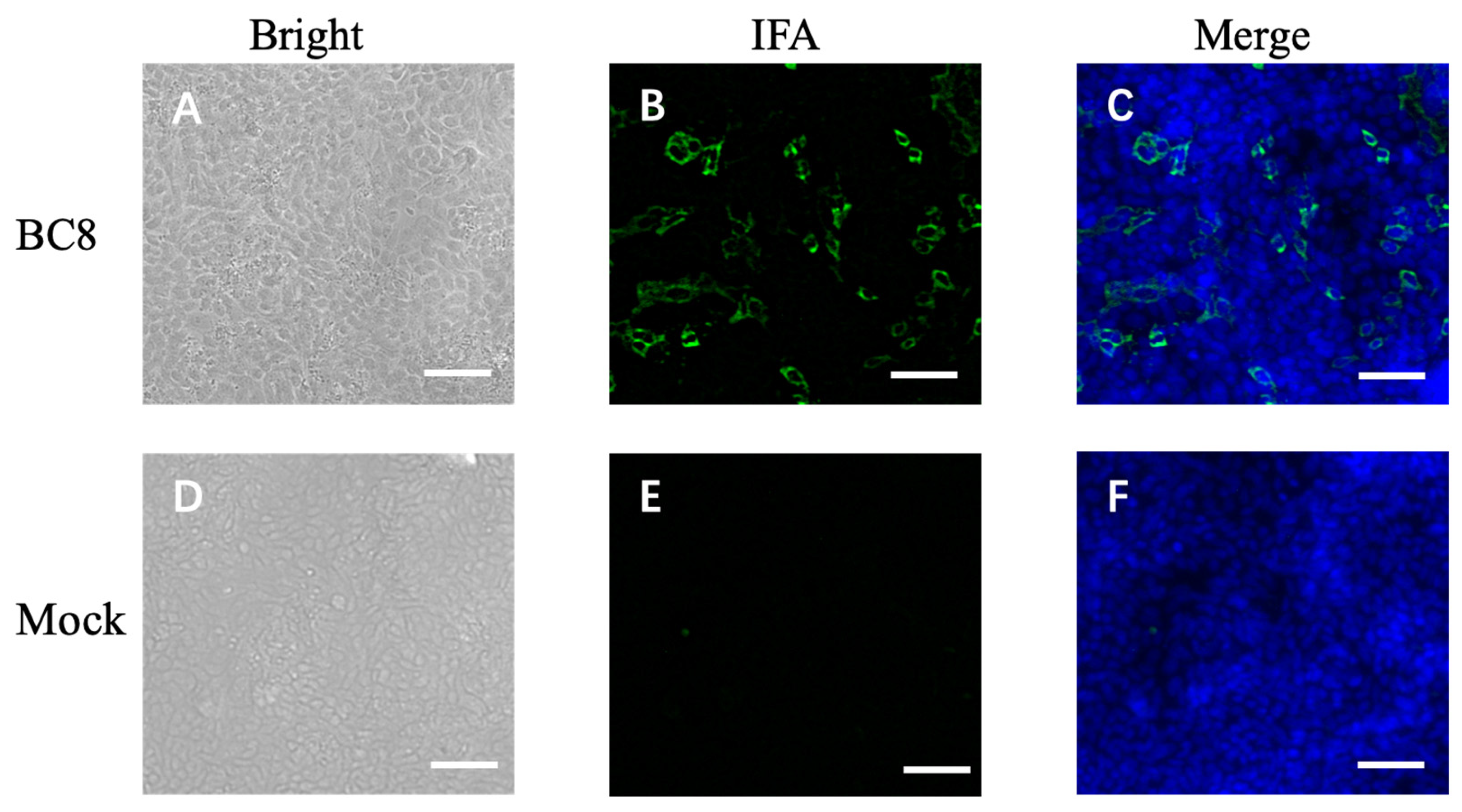
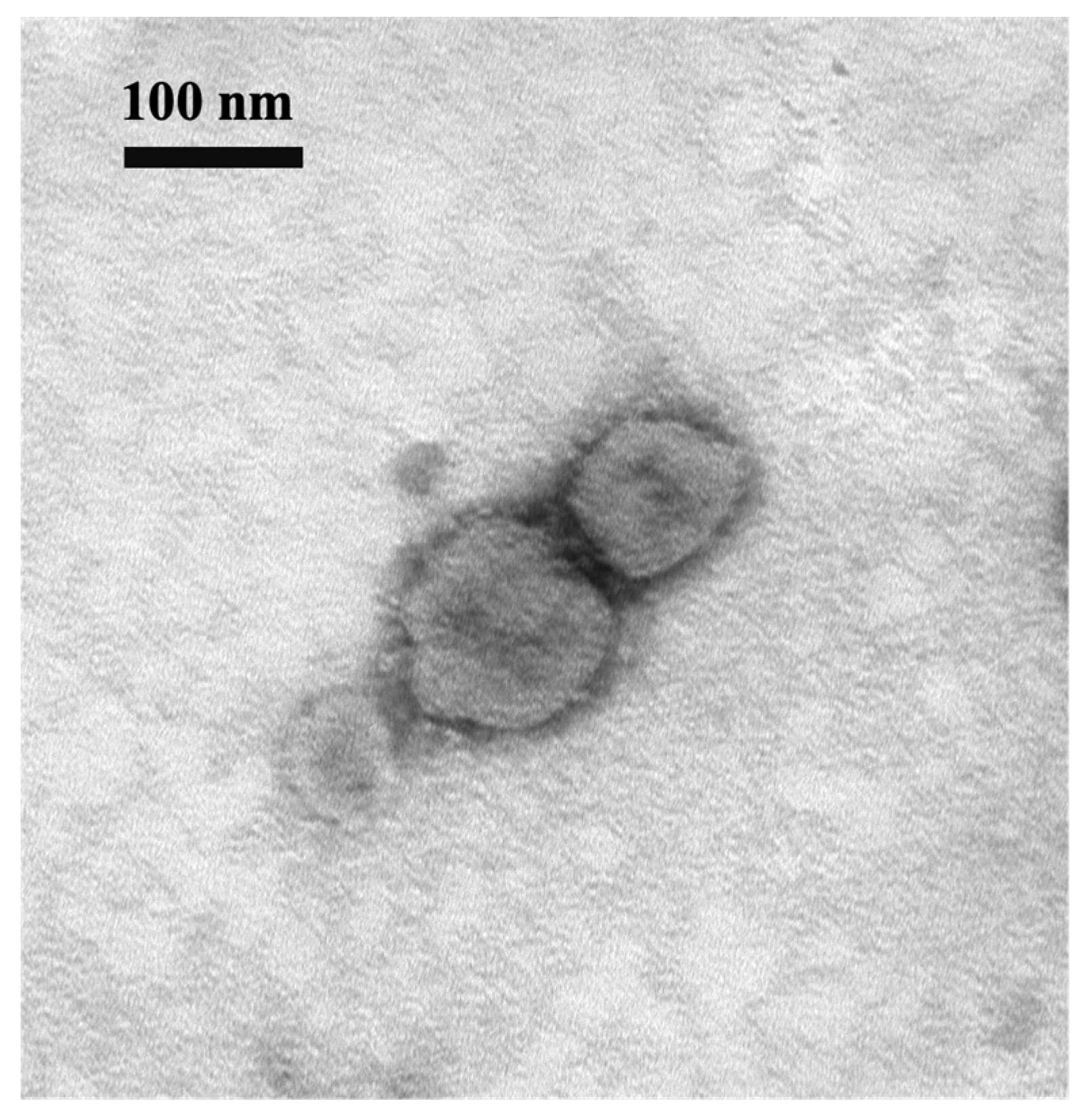
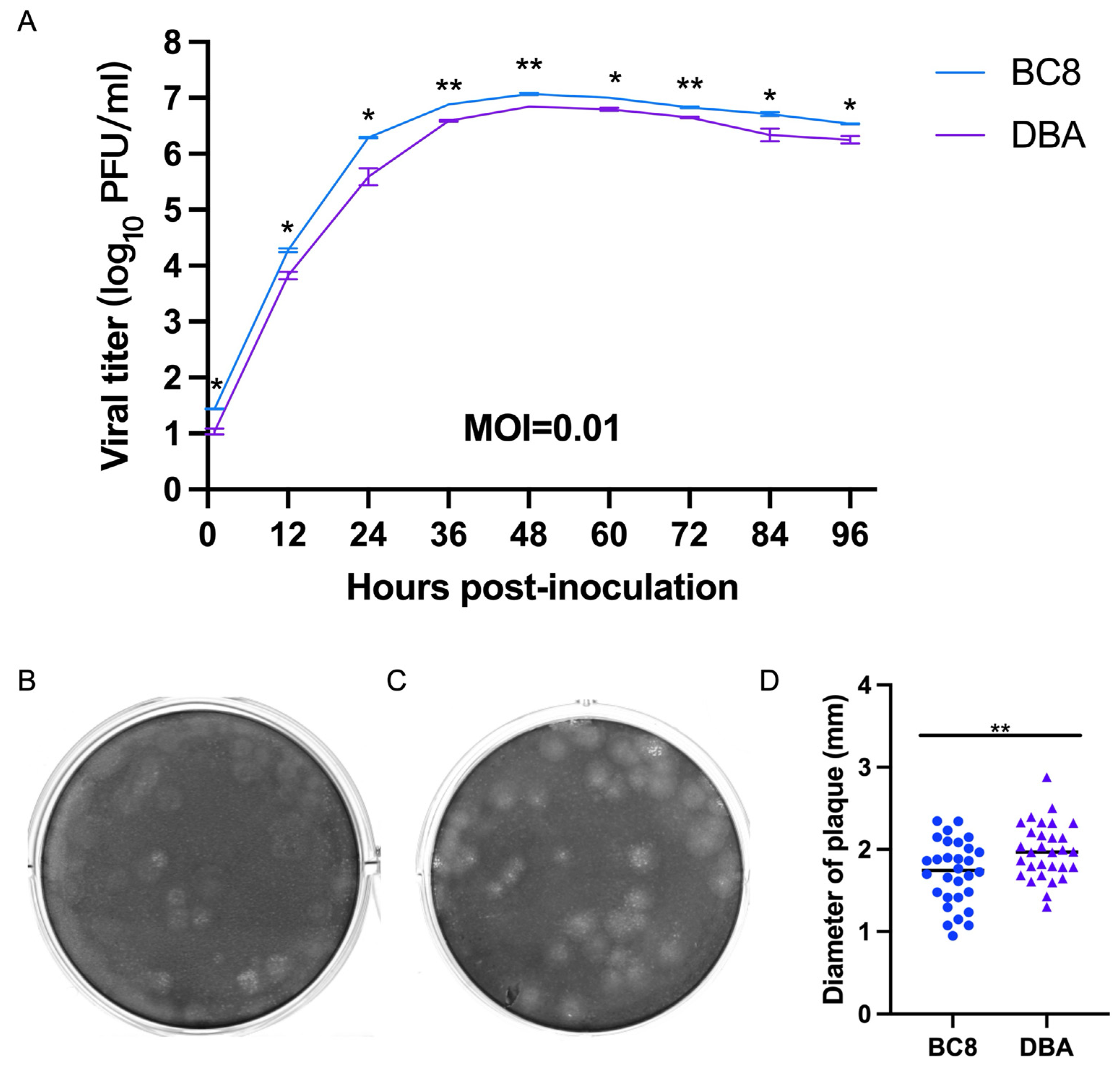



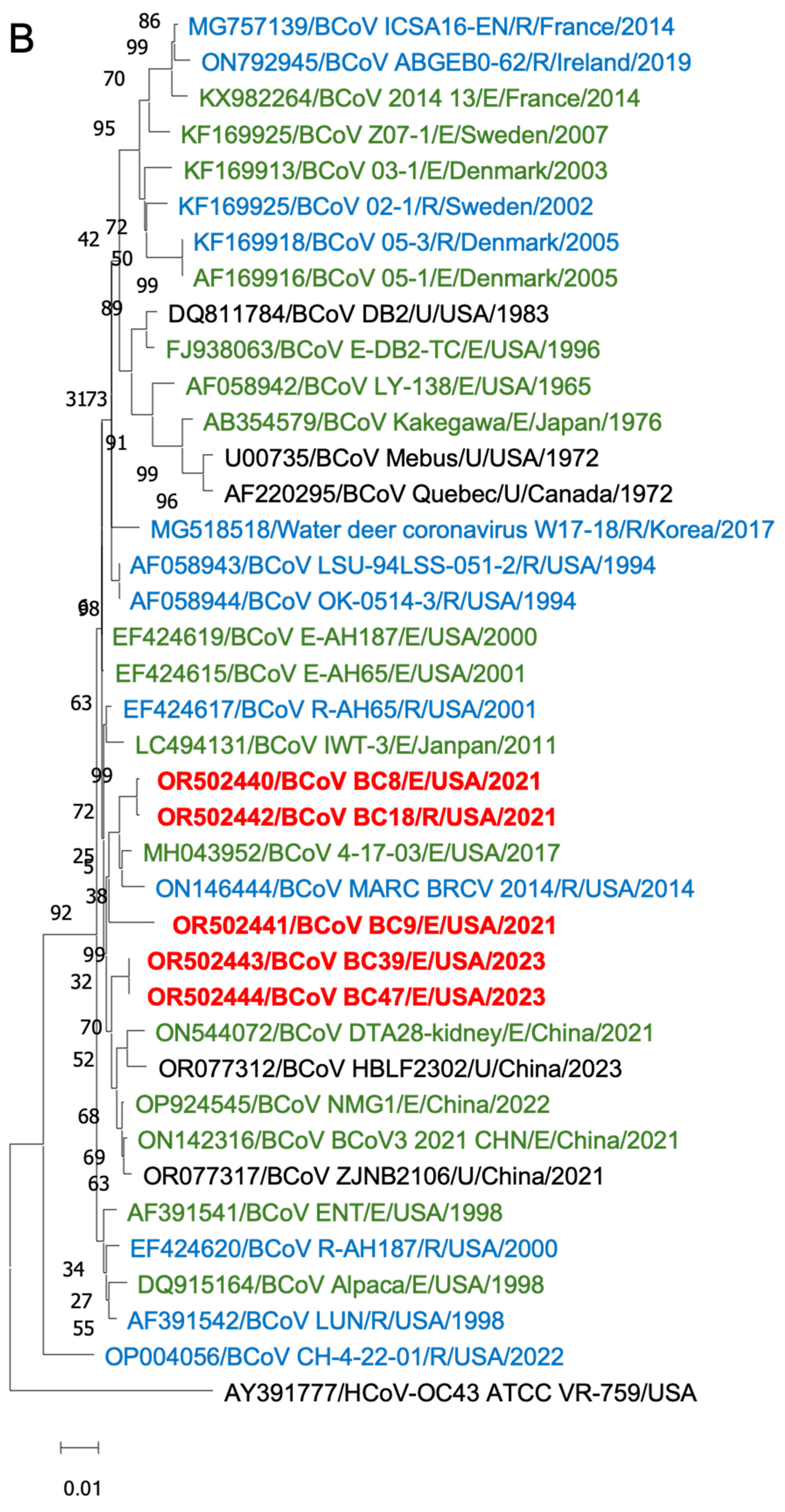
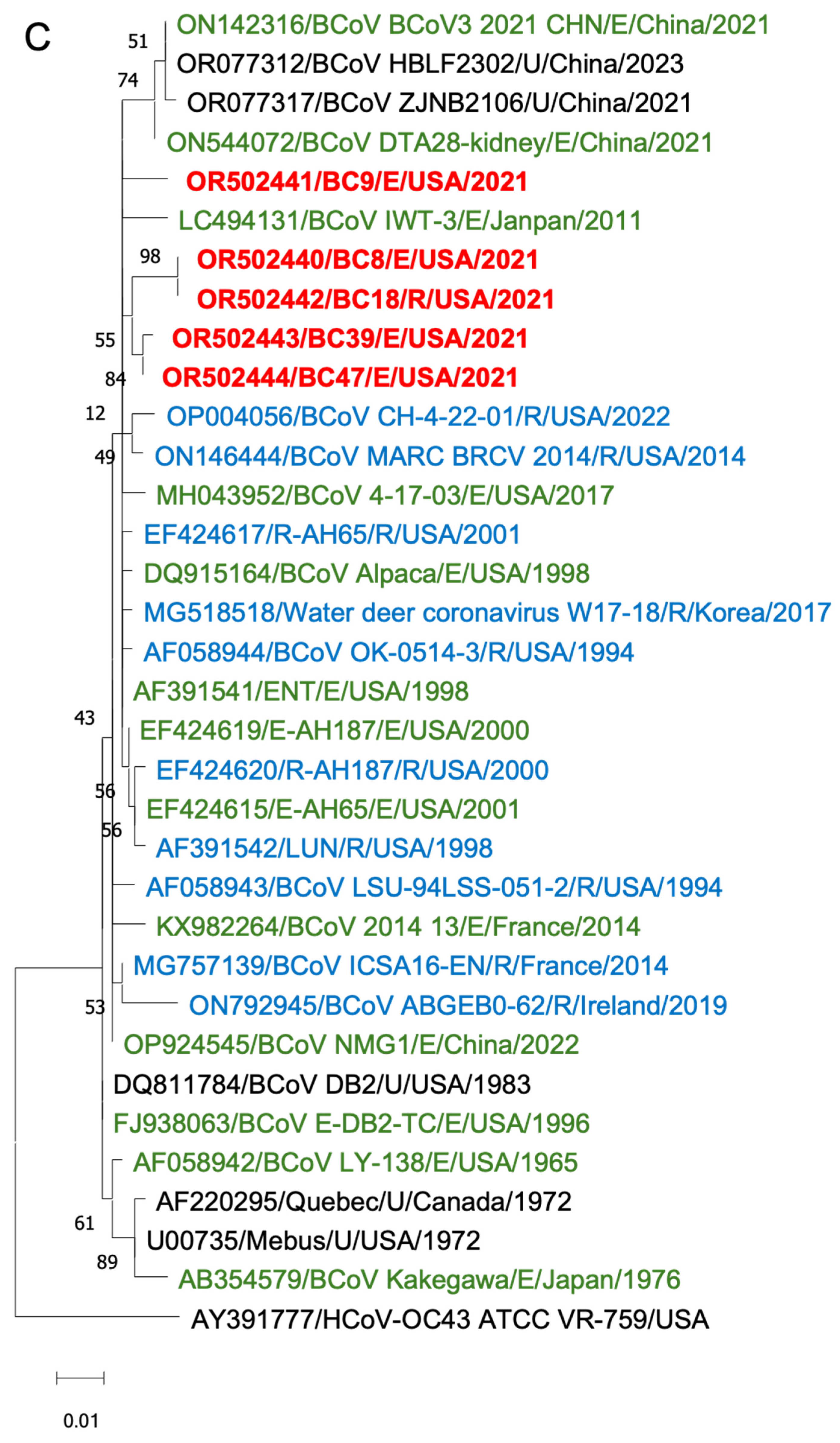
| Farm | Breed | Age | Type | Positive Samples 2 | Positive Rate (%) |
|---|---|---|---|---|---|
| OH | NA | Pre-weaned 3 | Fecal | BC7, BC8, BC9, BC10 | 4/10 (40) |
| Nasal | BC12, BC14, BC15, BC17, BC18, BC19 | 6/10 (60) | |||
| GA1 | Holstein | Pre-weaned 3 | Fecal | 0 | 0/18 (0) |
| Weaned | Fecal | BC33, BC39, BC47 | 3/11 (27) | ||
| Jersey | Pre-weaned 3 | Fecal | 0 | 0/6 (0) | |
| Weaned | Fecal | BC37 | 1/8 (13) | ||
| GA2 | Nigerian red | Pre-weaned 4 | Fecal | BC53 | 1/3 (33) |
| Weaned | Fecal | 0 | 0/1 (0) | ||
| GA3 | NA | Weaned | Fecal | 0 | 0/3 (0) |
| NA | Nursing beef | Fecal | 0 | 0/1 (0) |
| Position in S Protein | Consensus Amino Acid | OR502440/BC8/E (Animal 1) | EF424615/E-AH65/E (Animal 2) | AF391541/ENT/E (Animal 3) | EF424619/AH187/E (Animal 4) | OR502442/BC18/R (Animal 1) | EF424617/R-AH65/R (Animal 2) | AF391542/LUN/R (Animal 3) | EF424620/AH187/R (Animal 4) |
|---|---|---|---|---|---|---|---|---|---|
| 24 | V | * | L | * | * | * | * | * | L |
| 35 | S | F | * | * | * | F | * | * | * |
| 45 | N | * | * | * | * | * | * | K | * |
| 113 | I | * | * | * | * | * | V | * | * |
| 174 | P | S | * | * | * | S | * | * | * |
| 179 | Q | R | * | * | * | R | * | R | * |
| 370 | D | * | * | Y | * | * | * | * | * |
| 483 | P | * | * | S | * | * | * | * | * |
| 492 | D | G | * | * | * | G | * | * | * |
| 499 | N | * | S | * | S | * | S | * | * |
| 501 | S | * | * | P | * | * | * | P | P |
| 509 | T | * | N | * | N | * | N | * | * |
| 510 | T | * | * | S | * | * | * | S | S |
| 525 | H | Y | * | * | * | Y | * | * | * |
| 531 | D | * | * | * | * | * | N | * | * |
| 546 | P | S | * | * | * | S | * | * | * |
| 554 | Y | H | * | * | * | H | * | * | * |
| 571 | H | * | Y | * | Y | * | * | * | Y |
| 578 | S | * | * | T | * | * | * | T | * |
| 617 | T | I | * | * | * | * | * | * | * |
| 743 | S | * | * | * | * | * | * | * | I |
| 754 | S | * | * | * | * | * | * | * | N |
| 960 | P | * | * | * | * | L | * | * | * |
| 1052 | A | * | * | * | * | * | * | T | * |
| 1180 | D | * | * | * | * | * | G | G | G |
| 1192 | N | Y | * | * | * | Y | * | * | * |
| 1196 | T | * | * | * | * | * | * | * | S |
| 1232 | M | K | * | * | * | K | * | * | * |
| 1242 | D | * | * | Y | * | * | * | * | * |
Disclaimer/Publisher’s Note: The statements, opinions and data contained in all publications are solely those of the individual author(s) and contributor(s) and not of MDPI and/or the editor(s). MDPI and/or the editor(s) disclaim responsibility for any injury to people or property resulting from any ideas, methods, instructions or products referred to in the content. |
© 2024 by the authors. Licensee MDPI, Basel, Switzerland. This article is an open access article distributed under the terms and conditions of the Creative Commons Attribution (CC BY) license (https://creativecommons.org/licenses/by/4.0/).
Share and Cite
Li, Y.; Palomares, R.A.; Liu, M.; Xu, J.; Koo, C.; Granberry, F.; Locke, S.R.; Habing, G.; Saif, L.J.; Wang, L.; et al. Isolation and Characterization of Contemporary Bovine Coronavirus Strains. Viruses 2024, 16, 965. https://doi.org/10.3390/v16060965
Li Y, Palomares RA, Liu M, Xu J, Koo C, Granberry F, Locke SR, Habing G, Saif LJ, Wang L, et al. Isolation and Characterization of Contemporary Bovine Coronavirus Strains. Viruses. 2024; 16(6):965. https://doi.org/10.3390/v16060965
Chicago/Turabian StyleLi, Yu, Roberto A. Palomares, Mingde Liu, Jiayu Xu, Chohee Koo, Francesca Granberry, Samantha R. Locke, Greg Habing, Linda J. Saif, Leyi Wang, and et al. 2024. "Isolation and Characterization of Contemporary Bovine Coronavirus Strains" Viruses 16, no. 6: 965. https://doi.org/10.3390/v16060965
APA StyleLi, Y., Palomares, R. A., Liu, M., Xu, J., Koo, C., Granberry, F., Locke, S. R., Habing, G., Saif, L. J., Wang, L., & Wang, Q. (2024). Isolation and Characterization of Contemporary Bovine Coronavirus Strains. Viruses, 16(6), 965. https://doi.org/10.3390/v16060965







